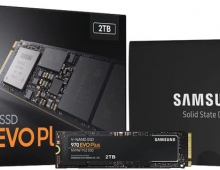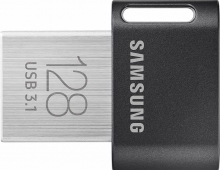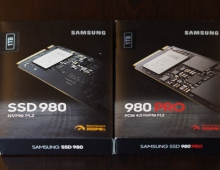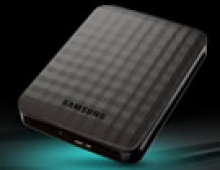Samsung SH-S182D SB02
2. CD-DVD Reading
Review Pages
2. CD-DVD Reading
3. CD Error Correction
4. DVD Error Correction
5. Audio & Data Protection Tests
6. CD Burning
7. Plextools CD Quality Measurements
8. Clover Systems CD Quality Measurements
9. DVD Writing Times
10. 18X DVD+R Writing Quality
11. 16X DVD+R Writing Quality
12. 8X DVD+R Writing Quality
13. 18X DVD-R Writing Quality
14. 16X DVD-R Writing Quality
15. 8X DVD-R Writing Quality
16. DVD +/- RW Writing Quality
17. DVD Writing Quality - Almedio
18. DVD DL Writing
19. DVD DL Writing Quality
20. Booktype
21. Conclusion
- CD Format
![]() For our CD transfer rate tests, we used the Nero CD-Speed utility and a set of Pressed CDs. Let's take a look at how the drive performed as compared with the other two drives.
For our CD transfer rate tests, we used the Nero CD-Speed utility and a set of Pressed CDs. Let's take a look at how the drive performed as compared with the other two drives.

All three drives support 48X CD reading speed. The starting speed for the Samsung drive was half that of the other drives at 10X, however its average reading speed was the highest as was the end speed of 50X.
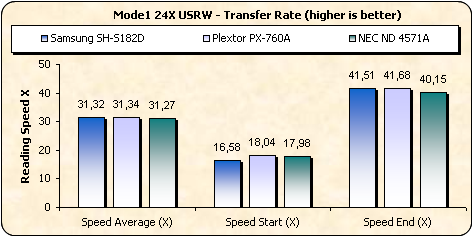
The max supported speed for CD-RW media is 40X for the three drives. In this test, all three drives had similar results with very little between them.
- AudioCD
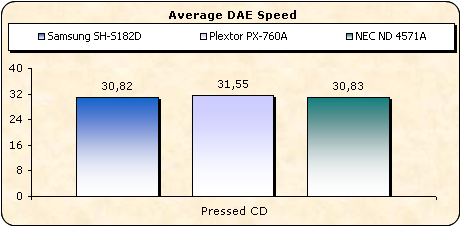
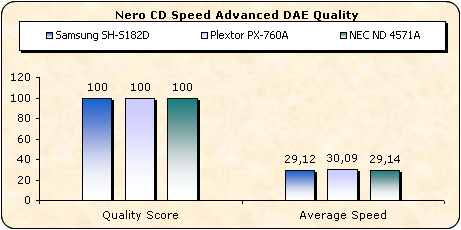
In AudioCD extraction, the supported speed for the drives is 40X. All three drives produced a perfect DAE quality score.

- 90mins Audio disc

- 99mins Audio disc

Surprisingly enough, the Samsung SH-S128D drive successfully read both the 90 and 99 min audio discs. Note, that not many DVD recorders out there are able to read these discs...
- DVD Format
![]() Now let's have a look at how the drive performs with DVD media. This time, a set of DVD media was used, both SL and DL.
Now let's have a look at how the drive performs with DVD media. This time, a set of DVD media was used, both SL and DL.

16X reading speed on DVD-ROM Single Layer media was achieved by all the tested drives. Any speed differences between the drives are negligible.
The two layers of a PTP DVD-ROM disc are read sequentially with the drive starting reading from the inner part of the disc, which is the beginning of each layer, progressing towards its outer range.
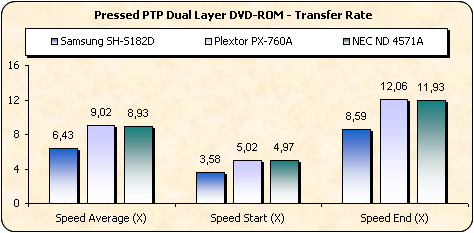
- With DVD DL media, the Samsung was noticeably slower, due to the fact that it supports a lower reading speed of 8X with DL media.
The above graph shows the reading performance of the drive with OTP dual layer media. The first layer of an OTP dual layer DVD-ROM is read exactly the same way as the first layer of the PTP disc we tested previously. The difference here is the reading strategy of the second layer of the disc. The beginning of the second layer is located in the outer part of the disc, so the drive starts reading from the outer tracks towards the inner part of the disc.

- Once again, the Samsung drive was slower.


The supported reading speeds for DVD±R/RW media are very important since these are the most common formats. The Samsung and Plextor drives support only 12X reading for DVD±R and the Samsung is the slowest reader for DVD±RW supporting only 8X. The average reading speeds presented in the graphs above reflect this.

Slow average ripping speed was produced by the Samsung SH-S182D...
- DVD-RAM
The drive can read read and write DVD-RAM media at 12X. Unfortunately, we did not have any 12X media available, but Samsung will be sending us some samples so that we can complete our tests. This review will be updated as soon as we have those results. In the meantime, we carried on with our usual test with 5X DVD RAM media. For our test, we used a 5X DVD-RAM disc from Maxell, burned with the LG GSA-4120B. The disc was read without any problems.
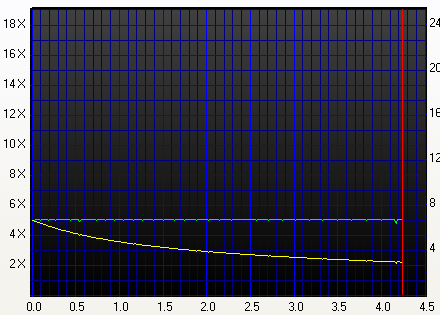
-Appendix
Nero CD-DVD Speed Graphs
CD Pressed / US-RW / AudioCD
DVD Pressed SL / DVD Pressed PTP DL / DVD Pressed OTP DL / DVD-R / DVD-RW / DVD+R / DVD+RW / DVD-RAM 5x
Review Pages
2. CD-DVD Reading
3. CD Error Correction
4. DVD Error Correction
5. Audio & Data Protection Tests
6. CD Burning
7. Plextools CD Quality Measurements
8. Clover Systems CD Quality Measurements
9. DVD Writing Times
10. 18X DVD+R Writing Quality
11. 16X DVD+R Writing Quality
12. 8X DVD+R Writing Quality
13. 18X DVD-R Writing Quality
14. 16X DVD-R Writing Quality
15. 8X DVD-R Writing Quality
16. DVD +/- RW Writing Quality
17. DVD Writing Quality - Almedio
18. DVD DL Writing
19. DVD DL Writing Quality
20. Booktype
21. Conclusion

